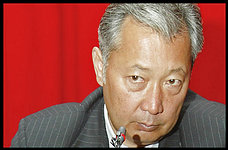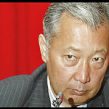
KULOV MODERATES HIS DEMANDS AGAINST PRESIDENT, BUT BISHKEK STILL TENSE
Publication: Eurasia Daily Monitor Volume: 4 Issue: 73
By:

On April 11 thousands of people gathered in central Bishkek, the Kyrgyz capital, to demand early presidential elections and a return to the November 2006 constitution. According to various estimates, between 4,000 and 12,000 supporters of two major opposition blocs, United Front and For Reforms, were present at different times of the day. The rallies are ongoing and their duration or outcomes are difficult to predict.
Former prime minister Felix Kulov, now leader of the United Front, had forecast earlier the April 11 demonstration would lead to a “transfer of state power in a peaceful way,” hinting that President Kurmanbek Bakiyev would be bound to step down in the face of widespread popular opposition. Although the majority of the Kyrgyz public today is deeply disappointed with Bakiyev, Kulov’s forecast had raised fears that civil clashes might erupt as a result of the opposition’s radical demands. Kulov’s determination to remove Bakiyev is also tinged by the frequent struggle between Kyrgyzstan’s northern and southern political elites.
However, the April 11 demonstration did not lead to a transfer of state power. As Edil Baisalov, leader of the NGO Coalition for Democracy and Civil Society, told Jamestown, Kulov has now failed to achieve his stated goal of removing the president as planned on April 11. Furthermore, Baisalov argued, if the opposition fails to win at least some substantial changes in Bakiyev’s politics, these demonstrations will go down as a victory for the president. Therefore, the opposition, according to Baisalov, needs to push the president to organize a national referendum to adopt a new constitution and stage early parliamentary elections. At this point, if the demonstrations continue, they could loose their rationale or lead to a political stalemate.
Feeling the growing pressure, this week Bakiyev eased control over the national TV channel and introduced a new constitutional project for the parliament’s consideration. Almazbek Atambayev, the opposition leader recently appointed prime minister, has made the argument that a peaceful transformation of state power actually began on March 30, the day he assumed office. He has stressed the fact that early presidential elections will increase existing north-south tensions and lead to destabilization. However, the United Front has condemned Atambayev for helping the president to escape the opposition’s pressure. Previously Bakiyev has shown that he often takes ad hoc decisions to retain his hold on power, and as prime minister Atambayev will not be able to change the president’s behavior.
Kulov, for his part, has redefined the goals that the April 11 demonstrations were intended to achieve. Instead of seeking the immediate removal of Bakiyev, he is now calling for early presidential elections. At a press conference on April 12, Kulov adopted a somewhat softer stance towards Bakiyev, concentrating mainly on the need to revoke the December 2006 constitution. Kulov claimed that about 50,000 people had gathered at the demonstration, but most local media outlets reported much lower numbers.
The April 11 demonstrations showed that the Kyrgyz opposition has become skilled at staging organized protests over the past two years. This time, hundreds of yurt and tents were set up to accommodate people who had traveled from other parts of the country, hot meals are being served, the demonstrators are dressed alike, and the organizers are trying to arrange for entertainment programs by inviting various artists and musicians. At the same time, security has been increased at the government headquarters and some 1,200 policemen deployed to monitor the rallies.
According to one Kyrgyz observer, it is highly likely that Kulov secured financial support to stage the demonstrations from external actors, possibly Kazakh and Russian sources. The main leaders of the current demonstrations are incumbent or former government representatives and parliamentarians, including Omurbek Suvanaliyev, Temir Sariyev, Melis Eshimkanov, and other well-known figures.
As Baisalov noted, the major lesson that all political actors must learn from the ongoing demonstrations is that there should not be absolute winners in the political struggle; instead compromises must prevail. Indeed, the process adopting the November 2006 constitution set an important precedent for achieving political compromises between the government and opposition (see EDM, November 9, 2006).
As one U.S. scholar commented to Jamestown, the events that have taken place in Kyrgyzstan since March 24, 2005, the day of the Tulip Revolution, have been chaotic and “crazy.” But the larger picture of the developments in Kyrgyzstan provides important lessons in civic education not only for the Kyrgyz public, but also to the Central Asian region in general.
(24.kg, Akipress.kg, Bely parohod, Ferghana.ru, March 15-April 11)




